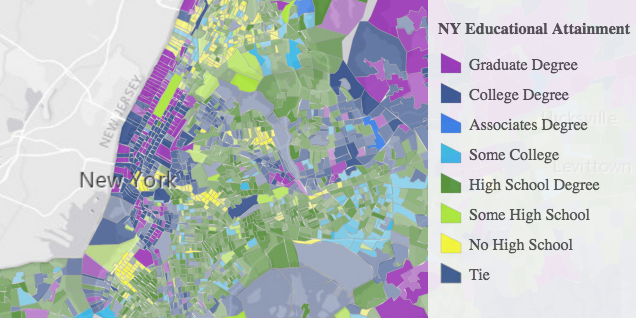The Legend widget displays labels and symbols for layers in a map. Labels and their corresponding symbols depend on the values set in the Renderer of the layer. The legend will only display layers and sublayers that are visible in the view.
The legend automatically updates when
- the visibility of a layer or sublayer changes
- a layer is added or removed from the map
- a layer's
renderer,opacity, ortitleis changed - the
legendEnabledproperty is set tofalseon the layer
You can use the view's DefaultUI to add widgets to the view's user interface via the ui property on the view.
Known Limitations
- There are no legends available for the following layer types: ElevationLayer, IntegratedMeshLayer, OpenStreetMapLayer, PointCloudLayer, VectorTileLayer, and WebTileLayer, so these will not display in the Legend widget.
- At 4.4, MapNotesLayer is not supported by Legend widget.
- 3D symbols with more than one symbol layer are not supported.
- Size in volumetric 3D symbols, such as polygon extrusion, is not depicted by Legend.
var legend = new Legend({
view: view,
layerInfos: [{
layer: featureLayer,
title: "Legend"
}]
});
view.ui.add(legend, "bottom-right");Constructors
new Legend(properties)
properties Object See the properties for a list of all the properties that may be passed into the constructor. |
// typical usage
var legend = new Legend({
view: view
});Property Overview
| Name | Type | Summary | |
|---|---|---|---|
| String | HTMLElement | The ID or node representing the DOM element containing the widget. more details | more details | |
| String | The name of the class. more details | more details | |
| Boolean | When | more details | |
| String | The unique ID assigned to the widget when the widget is created. more details | more details | |
| Object[] | Specifies a subset of the layers to display in the legend. more details | more details | |
| MapView | SceneView | A reference to the MapView or SceneView. more details | more details | |
Property Details
containerString|HTMLElement
The ID or node representing the DOM element containing the widget. This property can only be set once.
declaredClassStringreadonly
The name of the class. The declared class name is formatted as
esri.folder.className.destroyedBoolean
When
true, this property indicates whether the widget has been destroyed.idString
The unique ID assigned to the widget when the widget is created. If not set by the developer, it will default to the container ID, or if that is not present then it will be automatically generated.
layerInfosObject[]
Specifies a subset of the layers to display in the legend. If this property is not set, all layers in the map will display in the legend. Objects in this array are defined with the properties listed below.
Method Overview
| Name | Return Type | Summary | |
|---|---|---|---|
Destroys the widget instance. more details | more details | ||
| Boolean | Indicates whether there is an event listener on the instance that matches the provided event name. more details | more details | |
| Object | Registers an event handler on the instance. more details | more details | |
Widget teardown helper. more details | more details | ||
This method is primarily used by developers when implementing custom widgets. more details | more details | ||
| Object | This method is primarily used by developers when implementing custom widgets. more details | more details | |
Renders widget to the DOM immediately. more details | more details | ||
This method is primarily used by developers when implementing custom widgets. more details | more details | ||
Finalizes the creation of the widget. more details | more details | ||
Method Details
destroy()inherited
Destroys the widget instance.
Indicates whether there is an event listener on the instance that matches the provided event name.
Parameter:type StringThe name of the event.
Returns:Type Description Boolean Returns true if the class supports the input event. Registers an event handler on the instance. Call this method to hook an event with a listener. See the Events summary table for a list of listened events.
Parameters:type StringThe name of event to listen for.
listener FunctionThe function to call when the event is fired.
Returns:Type Description Object Returns an event handler with a remove()method that can be called to stop listening for the event.Property Type Description remove Function When called, removes the listener from the event. - See also:
Example:view.on("click", function(event){ // event is the event handle returned after the event fires. console.log(event.mapPoint); });own(handles)inherited
Widget teardown helper. Any handles added to it will be automatically removed when the widget is destroyed.
Parameter:handles Handle[]@type - handles to remove when destroyed
postInitialize()inherited
This method is primarily used by developers when implementing custom widgets. Executes after widget is ready for rendering.
This method is primarily used by developers when implementing custom widgets. It must be implemented by subclasses for rendering.
Returns:Type Description Object The rendered virtual node. renderNow()inherited
Renders widget to the DOM immediately.
scheduleRender()inherited
This method is primarily used by developers when implementing custom widgets. Schedules widget rendering. This method is useful for changes affecting the UI.
- Deprecated
startup()inherited
- since version 4.2.
Finalizes the creation of the widget.
